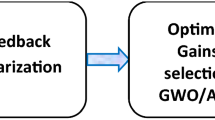Abstract
Double fed induction generators are able to operate on different power factors, and can be used to support power systems. On the basis of regulating the power factors of double fed induction generators, the wind power penetration conditions are taken into account; the hybrid artificial bee colony algorithm is proposed to calculate the optimal power flow, and the impact of different power factors on the power system is researched. In this chapter, the model of objective function is formulated to minimize the conventional generator cost under the consideration of various power factors of double fed induction generators. The simulation results show in high wind speed, double fed induction generators can regulate power factors to support power system operations and reduce the conventional generator cost, and the hybrid artificial bee colony algorithm is better for the converged speed of algorithm than the artificial bee colony algorithm. Thus, the model and new algorithm are proved effectively.
Access this chapter
Tax calculation will be finalised at checkout
Purchases are for personal use only
Similar content being viewed by others
References
Lang Y, Zhang X, Xu D. Reactive power analysis and control of doubly fed induction generator wind farm [J]. Proc CSEE. 2007;27(9):77–82 (In Chinese).
Tapia A, Tapia G, Ostolaza JX. Reactive power control of wind farms for voltage control applications [J]. Renew Energy. 2004;29(3):377–92.
State Grid Corporation of China. Regulations on accessing power system technology to wind electric field in State Grid [R]. Beijing: State Grid Corporation of China; 2009.
Mao Q. Compensating reactive power loss of wind farm with reactive power generated by wind turbine generators [J]. Power Syst Technol. 2009;33(19):175–80 (In Chinese).
Liu Y, Wang W, Wang Y. Research on wind farm models for power flow calculation [J]. East China Electr Power. 2008;36(4):446–9 (In Chinese).
Wang X. Modern power system analysis [M]. Beijing: Science Press; 2003. pp. 116–34.
Shen H. Studies on integrated variable-speed constant-frequency wind turbine models and the application [D]. Beijing: China Electric Power Research Institute; 2003.
Zhao J, Li X, Hao J. Reactive power control of wind farm made up with doubly fed induction generators in distribution system [J]. Electr Power Syst Res. 2009;80(6):698–706.
Abido MA. Multiobjective optimal power flow using strength Pareto evolutionary algorithm [C]. Universities Power Engineering Conference, IEEE; 2004. pp. 457–61.
Yue Y. Method of unit commitment based on an improved artificial bees colony algorithm [D]. Zhejiang: Zhejiang University; 2012.
Ren X, Zhou L, Zhao F, et al. Reactive power optimization of distribution network based on artificial bee colony algorithm [J]. Mod Electr Power. 2012;29(4):41–5 (In Chinese).
Ding H, Feng Q. Artificial bee colony algorithm based on boltzmann selection policy [J]. Comput Eng Appl. 2009;45(31):53–5 (In Chinese).
Gu W, Yin M, Wang C. Self adaptive artificial bee colony for global numerical optimization [J]. IERI Procedia. 2012;1:59–65.
Sumpavakup C, Srikun I, Chusanapiputt S. A solution to the optimal power flow using artificial bee colony algorithm[C]. 2010 International Conference on Power System Technology, IEEE; 2010. pp. 1–5.
Sumpavakup C, Chusanapiput S, Srikun I. A hybrid cultural-based bee colony algorithm for solving the optimal power flow [C]. 2011 IEEE 54th International Midwest Symposium on Date, IEEE; 2011. pp. 1–4.
Zhang B, Chen S, Yan Z. Analysis of advanced power network [M]. Beijing: Tsinghua University Press; 2007. pp. 311–3.
Author information
Authors and Affiliations
Corresponding author
Editor information
Editors and Affiliations
Rights and permissions
Copyright information
© 2015 Springer International Publishing Switzerland
About this paper
Cite this paper
Hao, X., Jiang, C., Wu, L., Zhang, L. (2015). Based on the Power Factors of DFIG Wind Farm for Power Flow Optimization. In: Wang, W. (eds) Proceedings of the Second International Conference on Mechatronics and Automatic Control. Lecture Notes in Electrical Engineering, vol 334. Springer, Cham. https://doi.org/10.1007/978-3-319-13707-0_18
Download citation
DOI: https://doi.org/10.1007/978-3-319-13707-0_18
Published:
Publisher Name: Springer, Cham
Print ISBN: 978-3-319-13706-3
Online ISBN: 978-3-319-13707-0
eBook Packages: EngineeringEngineering (R0)




